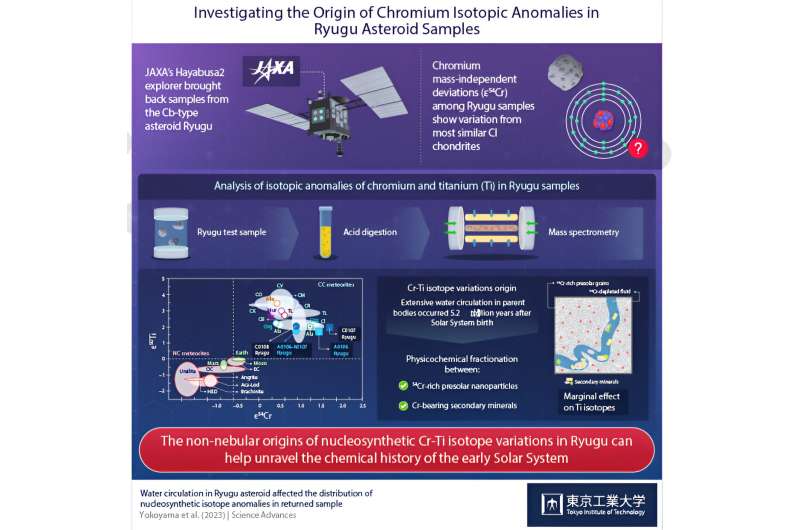November 9, 2023 report
This article has been reviewed according to Science X's editorial process and policies. Editors have highlighted the following attributes while ensuring the content's credibility:
fact-checked
peer-reviewed publication
trusted source
proofread
Water on asteroid Ryugu's parent found to have shaped distribution of its elements

A large international team of space scientists, geochemists, and engineers, has found that water that existed on the parent of Ryugu had an impact on the distribution of elements on the asteroid. In their paper published in the journal Science Advances, the group describes how they compared two isotopes of both chromium and titanium and what the differences they found told them about Ryugu's history of exposure to water before it broke away from its parent body.
Ryugu is a near-Earth asteroid that has been the object of much research since it was first discovered back in 1999. In 2014, JAXA launched a spacecraft called Hayabusa2 that ventured to the asteroid, collected samples from it and returned them to Earth in 2020.
Over the past three years, hundreds of research efforts have been conducted involving study of the material returned from Ryugu. Such efforts have revealed a lot about the nature of the asteroid and its parent body—the asteroid is believed to have broken away from a much larger asteroid from either the Polana or Eulalia families, due to a collision with another asteroid.
In this new effort, the research team focused its efforts on two isotopes of chromium and two of titanium, hoping to learn more about Ryugu's exposure to water while still a part of its parent body. They note that all four isotopes are very stable, and thus do not break down easily under dry conditions, which suggests their amounts are the same now as they were when the asteroid broke away from its parent.
In comparing the ratios between the isotopes of titanium, they found very little variance, which was expected. That was not the case with the ratios between isotopes of chromium, however; they varied by nearly a factor of two. The researchers suggest that such a variance could be easily explained by exposure to water, as chromium dissolves in water.
Such water, they note, would have exerted its influence on Ryugu while it was still part of its parent because, afterward, the asteroid was too dry. The team also found differences in variance based on where a sample was collected from the asteroid, showing that water was moving around on the parent body prior to losing Ryugu.
The researchers note that their findings agree with other researchers who used a different path to find evidence of water on Ryugu's parent body.
More information: Tetsuya Yokoyama et al, Water circulation in Ryugu asteroid affected the distribution of nucleosynthetic isotope anomalies in returned sample, Science Advances (2023). DOI: 10.1126/sciadv.adi7048
Journal information: Science Advances
© 2023 Science X Network





















